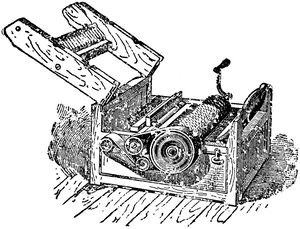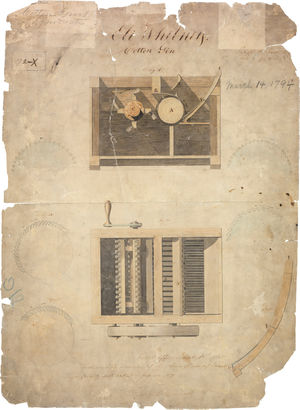Cotton Gin
This article was initially written by Robert Woods, ASME Fellow. This article contains material published in Mechanical Engineering Magazine Sept. 2009. Copyright 2009 American Society of Mechanical Engineers
As engineers, we are in the business of taking something that exists only in the mind, making it tangible, and putting it out into the real world. This usually involves a depth of understanding and a high degree of ingenuity.
But there have been cases in which the mere fact of an engineer's having been on the scene at the right time produced an effect totally om of proportion to what may have been a negligible amount of real engineering. The cotton gin might be history's best example of that.
Eli Whitney conceived it almost on the spur of the moment. He went on to other things and became famous as an engineer, but the gin, which itself was a very simple mechanism, went farthest to ensure his place in history.
References to the cotton gin are so numerous that the term has become almost a single word in every English vocabulary. ("Gin" is a corruption of "engine," itself a term for any machine.) It is significant that one rarely sees an illustration of this legendary machine, although we hear of it often enough. Knowing as much as we do about its reputation and being conditioned to expect a revelation, what a present-day engineer sees when he actually looks into the hardware is an anticlimax.
Historical significance is obviously not proportional to mechanical complexity. Only after comparing the economy of the American South before and after the introduction of the gin can we appreciate its real impact. The gin was more important sociologically than technically. Before the gin, slavery had been on its way out. Farmers had learned that it cost more to maintain a slave than he could produce - if a human was to be judged on a purely monetary basis.
Before introduction of the gin, cotton had been a mildly interesting but barely productive crop. That changed dramatically with the advent of the gin. Prior to the gin's introduction cotton fiber could only be separated from the sticky, embedded seeds by a manual operation.
The procedure was so slow that cotton was just barely commercially attractive. So little could be produced that the greatest application was in such specialized little things as candle wicks. An individual would work ten hours to separate a pound of fiber from seeds.
Production increased by a staggering amount with the introduction of the cotton gin. A team of two or three could then process fifty pounds of cotton in a single day. Cotton growing suddenly became lucrative, and an unexpected tidal wave of cotton fields sprang up. It soon became by far the major export of the South.
Growth and harvesting of cotton was very labor intensive, and thus the demand for manpower led to a sharp increase in what had previously been a small traffic in slaves. The climate and the agricultural experience in the South were more suitable for cotton growth than in the North. These factors caused the importation of slaves to be heavily directed toward the South. Although there was initially no law against slavery in the North, the North played a relatively small part in the slave trade. This dichotomy in culture inevitably led to the catastrophe that we know as the Civil War. And it was all precipitated by a very simple machine.
The mechanism is primitive by our standards. Any high school student competing in a science fair could come up with the same thing.
This is not to denigrate Whitney's ingenuity. He lived in a time when no one had yet thought of applying machinery to a six-thousand-year-old problem. Cotton fabric had been known as early 4,000 B.C. in the Indus Valley. The fact that the earliest examples of cotton fabric were found in a river valley is significant. It is generally thought that the configuration of the cotton boll allowed plants, which were native to river banks, to proliferate by floating seeds downstream.
That twenty-first century science fair student would have had the advantage of growing up in a culture in which mechanical solutions to problems are no novelty; they are expected. That wasn't the case in the 1790s. But as with the steam engine, when all the pieces were at hand, it was inevitable that someone would put them together. Eli Whitney did that.
It was a matter of pure chance that Whitney found himself involved with cotton growing. After getting a degree from Yale he had gone South for a tutoring job in South Carolina. When the job did not materialize, he was offered a position by Catherine Littlefield Greene of Savannah and resolved to spend his time studying law. If he had persisted in that, world history might have been different.
Whitney's new landlady owned a plantation which grew a little cotton. She had inherited the farm, being the widow of Nathanael Greene, the Revolutionary War general. While he was with Catherine Greene, Whitney displayed a previously untapped genius for mechanical things. She brought this to the attention of a couple of fellow plantation owners while they were discussing the fact that there was no economical method of separating seeds from cotton fiber. Whitney recognized that it could be done mechanically and soon produced a design concept. Mrs. Greene is frequently overlooked when the history of the gin is described; nonetheless it appears that it was her suggestion to Whitney that led to its invention.
He spent some months reducing his concept to practice and building a prototype whose design was almost immediately stolen and counterfeited a vast number of times. Whitney was later involved in years of patent litigation which in the end brought him only a tiny fraction of the wealth he was entitled to. His patent was issued in 1794 and turned out to be of little value.
Following Whitney's innovation a major industry developed to manufacture gins and was well under way by the 1840s. To this day its descendants are producing now modernized gins. The Continental Eagle Corp., which can trace its ancestry back to 1832, now claims to have manufactured more gins than any other producer in the world.
The loss to piracy was not a total disaster for Whitney, because a decade later it was his reputation as an innovator that got him a government contract to produce ten thousand muskets - a previously unheard-of number.
Because of this contract, every engineer has heard that Whitney invented mass production, although the situation was not quite as simple as we are led to believe. An interesting sidelight is that Whitney casually invented, as a tool for manufacturing gun locks, the milling machine that is now the staple of machine shop production. It is eclipsed only by the drill press and the lathe.
The gin itself comprised a rotating drum with wire hooks or ratchet-like teeth that pulled cotton fibers between the teeth of a comb. The comb had teeth spaced too closely for seeds to pass through.
Only one aspect of the machine can be regarded as serious mechanisms design. A second drum, rotating faster than the first and carrying brushes, served to dislodge the cotton fibers from the first. This was driven, along with the larger drum, by a belt-and-pulley arrangement typically having a four-to-one ratio.
During its early days the entire mechanism was driven by manpower using a hand crank. Later machines were powered by steam engines and the belts were replaced with gears.
The operation is so straightforward that little explanation is required. In Whitney's patent application cotton bolls, seeds and all, were loaded into a hopper which guided them to the face of the comb. After being pulled through it by the toothed cylinder, the separated cotton fibers emerged at the left and the seeds were collected in a hopper at the right.
A computerized animation of Whitney's patent is currently available on line in the section devoted to the cotton gin at http://www.eliwhitney.org. The seeds, by the way, also have commercial value although not on the scale of the cotton fiber itself In addition to the familiar cottonseed oil, which is used in cooking and candy making, seeds are used in such widely assorted applications as cattle feed, paper, and as a source of cellulose for making nitrocellulose.
Whitney and his gin are monuments to Man's imagination, which can intrude on reality and, armed sometimes with only small pieces of the physical world, profoundly influence history. His gin involved only a few hundred kilograms of matter but it shaped the future of a nation and affected for all time the relations among the people who were to be born into it. It is rare that a single contrivance has such a profound social effect.
Only Galileo, with a few grams of optical glass in a telescope, had a greater impact on history. He removed the Earth from the center of the universe. Whitney brought about a social revolution.

